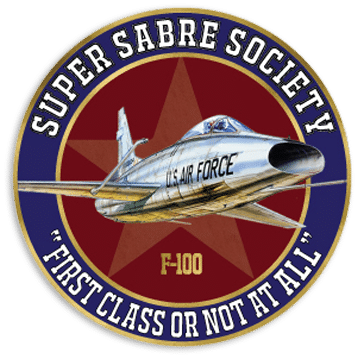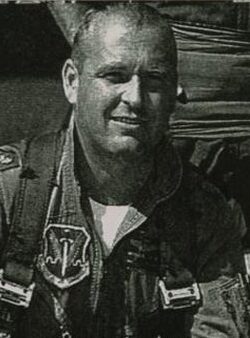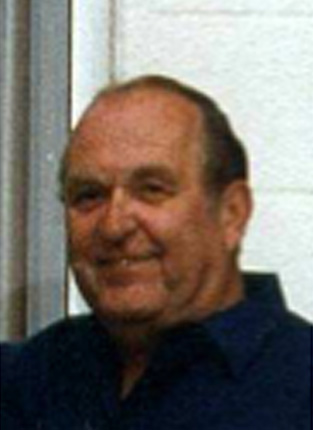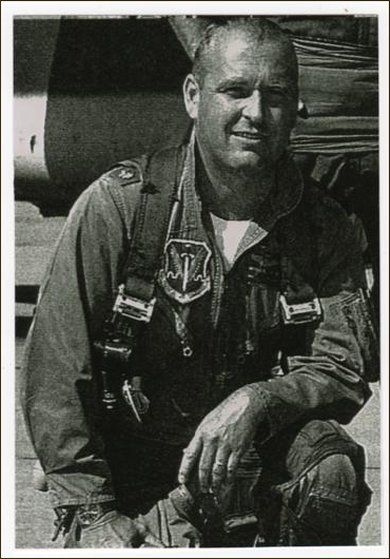1. Best Flying Experience — Combat sorties out of Bien Hoa & Tuy Hoa, RVN
2. Most Fun – Flying MK – 6 Sabres for 13 years as a civilian! Almost like being in the Air Force except you did not have to attend all the silly meetings!
3. 1995 – November – Retired/Retired
CLAIM STAKE: Just might be the oldest (56) SSS troop to ever experience an ejection and subsequent real no BULL_ _ _ _ survival situation. Ejected 85 miles at sea and was rescued by the Japanese Self Air Defense Force – but that’s another story and not an F – 100 one!
POST RETIREMENT:
1978 – 80 Private Business – Las Vegas, NV
1981 – 82 Technical Writer, McDonnell Douglas Aircraft – Red Flag Operations, Nellis AFB, NV
1982 – 95 Civilian Dart Tow Pilot/Operations, Kadena AB, Japan, Holloman AFB, NM, Wittmund AB, FRG, (T-33/MK-6 Sabre/F-100D/F)
Dumpy Wyrick Caterpillar Club Story
“JUST THE FACTS” – CRASH OF F-100C – SERIAL NUMBER 54-2080
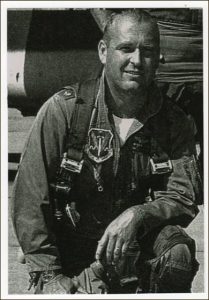
It was a Friday, October 2, 1959, and I was flying the morning gunnery schedule out of the 4514th CCTS, Luke AFB, AZ, and was assigned to Captain “Bobcat” Payne’s flight. As a student going through F–100 Combat Crew Training en-route to my first operational assignment in the PI, I was flying number three in a three-ship flight led by Major “Scrappy” Fair, the Operations Officer.
All the preflight planning was normal and had become rather routine by this time in the training program. The other student on this flight and I had completed all the pre-brief items, checking the weather and getting the winds. We completed the take-off data cards with the required information relative to range assignment (Range Three) and time, ordnance load, and lineup. The briefing had been the normal air-to-ground student mission brief. The mission was briefed for rockets, 45 degree dive bomb, and strafe events.
The flight departed operations with start, check-in, taxi, take-off, and join-up with normal procedures being followed on the way to the range for air-to-ground gunnery training. The skip and rocket events were completed and the flight maneuvered into the dive bomb pattern for a 45-degree dive. My first three dive passes were normal with no problems. My final dive pass (pass number 11) was completed and during the pull off, just as the nose was coming up through the horizon (and I was adding power to regain downwind altitude and position), I heard what sounded like a loud snap aft of the cockpit and became aware that the engine RPM was unwinding.
I pushed the throttle to the firewall, but the RPM continued to decay with a drop in TPT, associated with a very noticeable loss of thrust and engine noise. I immediately recognized that the engine had flamed out and I made a “Mayday” call as I was passing through approximately 5,000 feet, zooming and swapping airspeed for altitude in the direction of the downwind leg. No problem, just a flameout; and just like in the simulator and IAW the EMERGENCY CHECKLIST procedure, I retarded the throttle, turned on the air-start switch, selected emergency fuel and started advancing the throttle. Should not have been a problem.
Meantime, “Scrappy” had ask me for my altitude and position and I responded that I was rolling out on the downwind at 7,800 feet and 240 knots. He asked me for my engine readings to which I replied, RPM – 21%, TPT – somewhere around 300 degrees, oil pressure indication, and fuel flow at about 1,500 pounds, but with an unsuccessful air-start. I checked that the secondary bus tie in switch was on and “Scrappy” immediately gave me the air-start procedures, (as cited above plus stop cocking the throttle), to which I complied.
After a few seconds, he wanted to know my altitude and I told him I was descending through 6,500 feet at 220 knots, 21 %, 1,500 pounds of fuel flow, TPT somewhere near 300 degrees. Again, he gave me the air-start procedures and by that time I had spotted Gila Bend Auxillary Field and thought that with a little skill and some masterful airmanship, I might just be able to make a low-key position and dead stick the bird into Gila Bend.
That looked like a good option at the time and with my vast F -100 experience (approximately 60 – 70 hours) it would probably win many kudos from fellow students and instructors — if I pulled it off. What was that noise I heard? Oh yes, it was “Scrappy” asking me again how I was doing, what my cockpit indications were, my altitude and airspeed. I repeated the same information that I had previously stated and told him I was at 220 knots passing 5,000 feet descending. His next transmission was “Come on out – bailout – eject – eject”! Well, maybe not, not just yet anyway, I must have been doing something wrong and didn’t understand why it wouldn’t start.
I tried one more time – repeated the procedure as before, throttle coming around the horn and in my cross check I saw the altimeter passing 3,000 feet and descending. I suddenly realized that the range elevation was around 1,000 feet and I needed to get out now. Then that sound again, “Eject – Scrappy Three – Eject!”
Time was now of the essence, I immediately assumed the position and in one big motion raised the armrests, squeezed the triggers that fired the seat and was on my way. I recall looking down and seeing the vertical stabilizer passing directly below me as I had started to rotate forward in the seat. I also recall that just before I started the ejection procedure, it quickly flashed through my mind to try and beat the system. Now, as I was watching the stab pass beneath me, I reached for the lap belt only to realize that it was already open and I was out of the seat. My next thought was to pull the D Ring, as I was now hurtling at the ground straight down head first.
Suddenly I experienced a tremendous tug that felt like it was going to shuck me right out the bottom of the harness and I realized that the chute had opened and I was going to be fine. At about this time, I became aware that I had just swung out 90 degrees in my first oscillation and as I looked over my left shoulder I could see the chute behind me in what appeared to be a near collapsed condition.
Simultaneously, I caught a glimpse of the ground and could see that it was very close and thought that I was going to land flat on my back. My immediate thoughts were this is really going to hurt! Instinctively, I closed my eyes and waited for the impact. Nothing happened and I was now on the opposite side of my first oscillation although I had absolutely no idea what was going on. About this time with no apparent impact and no pain I decided to open my eyes and check what was happening. Just as I opened my eyes I was driven into the ground feet first, knees, elbows, hands, belly, and face with no semblance of any PLF – just excruciating pain in my right ankle and some swear words that sounded like “I just broke my damn ankle!”
The next thing I remembered was that I was trying to clear and spit out the dirt from my mouth (I had lost my mask in the ejection sequence) while holding my ankle with both hands. Spill the chute – no need to as it had already collapsed, and besides my ankle really hurts. I unhooked and got out of my harness –crap this ankle really hurts! However, after a few minutes of self-pity, I came to realize that maybe my ankle was not broken, so I attempted to stand up. I unbuckled the harness and stepped out of the chute. In the interim, “Scrappy” had made a couple of passes across the top of me, but I was too involved with my ankle to acknowledge him. Then he came again and I waved to let him know that I was OK.
The airplane impacted approximately 15 miles southwest of Gila Bend. Could I have made a low key? Not even in my wildest dreams! In retrospect some other lessons that I gleaned from this experience were: (1) even though the emergency procedure works in the simulator, there is no guarantee that it will in the real event; (2) I did most everything properly, zoomed the airplane swapping airspeed for altitude while employing the proper Emergency Procedures; (3) let the Flight Lead know that I had a problem; (4) followed his instructions to a point by doing the airstart sequence a couple of times and then ignored his direction to eject by trying “just one more”!
Today, I am still alive because: (a) I zoomed the aircraft initially, (b) I could not get to Gila Bend and shine my butt, (c) I had an automatic sequenced ejection and I could not beat the system – it saved my life.
The accident board determined that the cause was material failure in that the Teleflex cable linking the throttle and the fuel control had broken, and permitted the fuel control to unwind to approximately 21 %. This was fixed by a modification to the fuel controls that if throttle command was lost or with certain internal failures of the fuel control it should not retard below 82%.
I was picked up by the range crew in a large truck approximately 25 – 30 minutes after the ejection and transported to Gila Bend. I was then flown back to Luke and taken to the hospital for a physical that revealed that my ankle was only a bad sprain and not broken. I had numerous contusions in my groin and chest area from the parachute harness and a perfect impression of my left fist on the right side of my chest. For some reason, I had grasped my right side chute harness strap with my left hand prior to chute opening (perhaps I was afraid of falling out of the harness – I don’t know), but there it was.
My butt was severely bruised from the ejection and it then turned from blue to purple in a couple of days. Purple then became green and then dark green, like spoiled meat, after about another three or four days. I could hardly sit on a bed. I seem to recall that the ejection procedure for the F – 100C called for lowering the manual seat to the full bottom position, if possible. Of course, with my stature, I always flew with the seat full up and rudder pedals full back. During the ejection procedure, after the charge fired, the catapult started moving and it took an instant for the seat to start moving due to the full up position and hence the seat impact was exaggerated. I do not have an F- 100C Dash One and I am not completely sure of that procedure, but it does seem to stick in my mind.
These are just the facts – I was just a student aviator on the way to being “perhaps not the best, but certainly one of the finest”! That is my story – just the facts!
